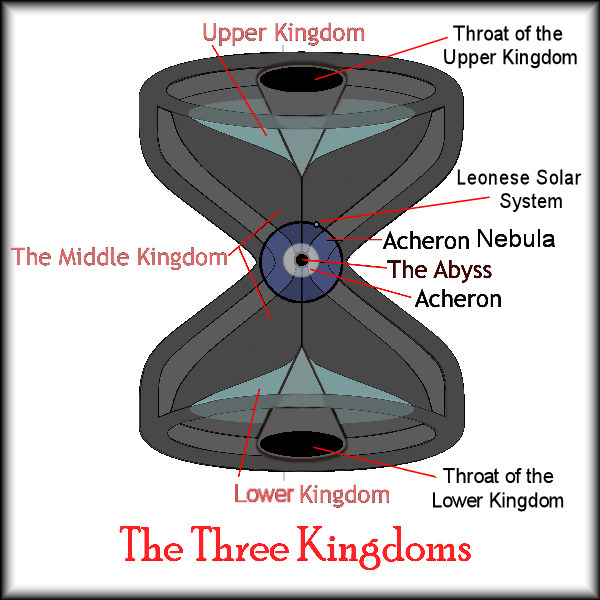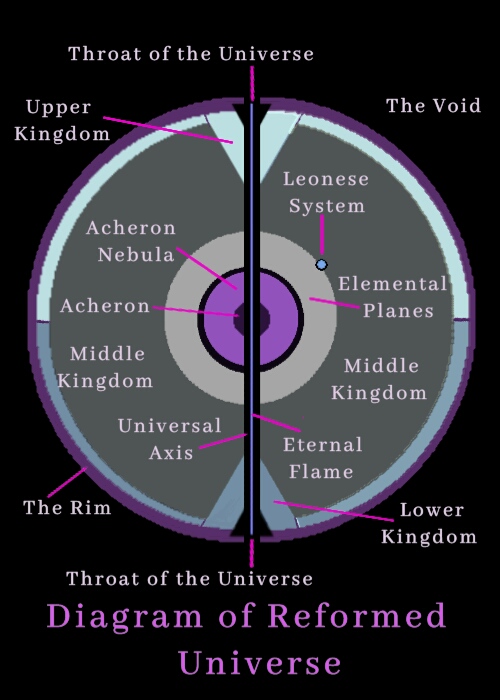The Seasons
- Summer: samhrah (sahv-rah)
Spring: ssaant (shay-ahn)
Autumn: beltain (bel-tayn)
Winter: marshoir (mayr-shwar)
How the Old Ones Measure Time
Yore: An Tosu Riamad (the beginning years) - Creation of the Universe, the Stars, and Planets.
1st Age: Mordath (Darkness) - Year 1- 500566855263 - creation of Morashtar, Dark Star and other worlds of the Morning Star.
2nd Age: Morgu (Fire) - Year 1- 75666999333 - creation of the first dragons.
3rd Age: Ruel (Water) - Year 1- 30159777363 - creation of the first great eagles.
4th Age: Mael (Chaos) - Year 1- 605368041 - creation of Bats, the Big Cats, Tsularian, Tsetar, Dragonkin, Arddanian Demons, Euryalians, Chiroptera Proto-Vampires, Pentacles Vampires, Goblins, Shaamae, Vengoath, and Elves.
5th Age: Mortarris (Seraph) - Year 1- 475000 - when the Tsetar dominated the world, creation of the Arcanon and Sephiroth.
6th Age: Nathracka-(Dragons) - Year 1- 47949 - when the demons and dragons dominated the world, the first rebellion of Haman and the fall of the Tsetar resulting in the creation of the Khorumal and Devils.
7th Age: Moruthsae (Humans) - Year 1-5250 - when outland humans first appeared and dominated the world.
8th Age: Namasae-(Namas) - Year 1- 4815 - when Namas dominated parts of the world
9th Age: Mythaen-(Elves) - Year 1- 11500 - when outland Trecouri appeared and elves dominated the world.
10th Age: Age: Wauru-(Lycanthrope) - Year 1-4645 - when lycanthrope first appeared.
11th Nasguol -(Vampires) - Year 1-14785 - when outland vampires appeared and dominated the world.
12th Age: Tsutar -(Fallen Angels) - Year 640... In Progress, the final rebellion in Haman and fall of all the Tsetar, creation of the Alamascan.
Ages are defined by when certain beings appeared and or dominated Morashtar by historical or archaeological accounts.

Prior Composition

Current Composition
At the central axis of the universe is the Acheron Nebula surrounding Acheron itself with the abyss at its core, while the Elemental sphere and Middle Kingdom of galaxies and planets surrounds Acheron and its nebula. Many planes are concentrated throughout the elemental sphere now surrounding Acheron and its nebula, the heavier elemental planes within with the more ephemeral planes without.
The lower kingdom and its realms lie at the southern hemisphere while the upper kingdom and its realms are at the northern hemisphere of the universal sphere. Where the universe was once an hourglass in shape, it expanded into a sphere when the great upper and lower kingdoms of Haman and Acheron fused. The abyss is at the core of Planet Acheron which is a part of both the lower and upper kingdoms, connected to both through the abyss by the throats and abyssal conduits of each, which form a sort of hyperspace shaft called the Great Trench or Axis.
The lower kingdom is where the underworlds are concentrated and is also called the Kingdom of Darkness. Humans would refer to it and Acheron as hell, though Acheron (vast as it is) which is more acurately Hell is only a small part of the lower kingdom. The Upper Kingdoms span a vast dominion on the furthest northern end of the Universe, and is also called the Kingdoms of Light. Haman, or Zion, called Heaven by humans, is part of the Upper Kingdom Major, while Valhalla and Elysium are part of the Upper Kingdom Minor. Many Pantheon Kingdoms, such as Tuatha of the An Dagda (upper Kingdom), Tartarus the realm of Hades (lower kingdom), Olympus of Zeus and the Olympian gods (upper kingdom), and Annwn the realm of Pen Annwn (lower kingdom), are overlapping parallel realms or demi-planes of either the upper or lower kingdoms and the worlds a pantheon is linked to. Several worlds might fall under the influence of a single pantheon to respect its deities or spirits in unique ways.
1st Age: Arsa-Ceylas Idahrmaeg (Age of the Immortals) - Year 1 - 606,999,514,199
2nd Age: Arsa-Mythaen - (Age of the Elves) - Year 1- 20,4815
3rd Age: Arsa-Namasae - (Age of the Humans) - Year 1- 5500
4th Age: Arsa-Wauru - (Age of the Lycanthrope) - Year 1- 4645
5th Age: Arsa-Nasguol - (Age of the Vampire) - Year 1- 14785
6th Age: Arsa-Tarnath - (Age of the Fallen) - Year 1-690... In progress
A Morashtar Year: There are 14 months in a year, and 434 days in a year compared to earth's 365 day year. That is 83 more days, and approximately 3.5 additional earth months. Not only are there more months and days in a solar year, but more hours in each day. There are 11,284 hours in a year, vs. earth's 8,760 hours, with a difference of 2524 hours. The reason for this is that Morashtar is a larger planet.
A Morashtar Day: Midnight to Midnight, 26 hours
A Morashtar Month: 31 days
Earth Date: AD 2005.
Morashtar Date: Year 1, 6th Age.
Present Earth Date: AD 2005.
Present Morashtar Date: Year 1, 6th Age.
The Lunar Months: From Fullmoon Midnight, to New Moon Midnight. Morashtar has three moons. The moon which determines the months is called Diaban-Gielas (goddess moon) and is not paired with the other two moons (Cael-Gielas and Enion-Gielas, the Son and Daughter moons) which can be seen in the sky one beside the other. Elanethel (Beautiful Daughter-is the daughter moon goddess), Caelru (Brave Son-is the moon-son god), Crielenna (Wise Mother, is the moon-mother goddess), Llewcrogh (Valiant Archer - is the moon father god and resides on Diaban-Gielas with his wife, Crielenna). All of these deities are elven and shapeshift. The climates below are for An Morendor (the Shadowlands).
1st Month: Unmial Maalun (month of the first moon) May 1-June 4
Summer Solstice - Mildest days of summer (65-75-North) (+2 Central) (+4 South)
2nd Month: Unmial Bolgdeaneg (month of basking) June 5-July 10
Summer - Mild days and nights (70-80-North) (+2 Central) (+4 South)
3rd Month: unmial Daanameg (month of building) July 11th-August 14
Summer - Hottest days of summer (80-85-North) (+2 Central) (+4 South)
4th Month: unmial Baeliceg (month of gathering) August 15-September 19
Autumn Equinox - Warmest days of autumn (70-80-North) (+2 Central) (+4 South)
5th Month: unmial Rubeig (month of rest) September 20-October 25
Autumn - Mildest days of autumn - (65-75-North) (+2 Central) (+4 South)
6th Month: unmial Fovar (month of harvest) October 26-November 29
Autumn - Coolest days of autumn (50-60-North) (+2 Central) (+4 South)
7th Month: unmial Celuir (month of celebration} November 30-January-4
Early Winter - Warmest days of winter (35-60-North) (+2 Central) (+4 South)
8th Month: unmial Ogham (month of study) January 5-Febuary 9
Winter Solstice - Coldest days of winter (0-45-North) (+2 Central) (+4 South)
9th Month: unmial Avhaist (month of practice) Febuary 10-March 17
Winter - Cold days of winter (20-32-North) (+2 Central) (+4 South)
10th Month: unmial Manaigharen (month of reflection) March 18-April 22
Winter - Warming days of winter (25-50-North) (+2 Central) (+4 South)
11th Month: unmial Bristloamhir (month of breaking earth) April 23-May 27
Early Spring - Coldest days of spring (35-50-North) (+2 Central) (+4 South)
12th Month: unmial Lireiloreg (month of planting) May 28-July 2
Spring Solstice - Cool days of spring (45-65-North) (+2 Central) (+4 South)
13th Month: unmial Ollghaireg (month of rejoicing) July 3-August 7
Spring - Warmest days of spring (55-70-North) (+2 Central) (+4 South)
14th Month: unmial Bethaed (month of nourishment) August 8-September 12
Early Summer - coolest days of summer (60-75-North) (+2 Central) (+4 South)